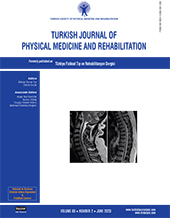The effects of forward head posture on expiratory muscle strength in chronic neck pain patients: A cross-sectional study
Patients and methods: Between June 2014 and November 2016 , a total of 99 patients (11 males, 88 females; mean age 54.1±9 years; range, 38 to 75 years) with chronic neck pain were evaluated for head posture by cervical lateral radiograph measuring the anterior head translation distance (FHPmm) and C7 vertebrae position (C7°). We examined the chest expansion by subtracting chest circumference from the level of xiphoid during maximal inspiration and expiration. Pain severity and neck disability were assessed using the Visual Analog Scale (VAS) and modified Neck Disability Index (MNDI), respectively. The respiratory functions were evaluated using spirometry tests, lung volumes, and maximal inspiratory and expiratory pressures (Pimax and Pemax, respectively).
Results: There was a negative correlation between the FHPmm with Pemax% (rho: -0.314; p=0.005). A negative correlation was also observed between C7° and Pemax, Pemax%, forced expiratory volume in one sec (FEV1)/forced vital capacity (FVC)%, forced expiratory flow (FEF)25-75%, and FEF75% (rho:-0.245, -0.349, -0.218, -0.214, and -0.259 respectively; p=0.028, 0.002, 0.035, 0.040, and 0.012, respectively). There was a positive correlation between neck disability and VAS scores (rho: 0.424; p<0.001), while there was a negative correlation between neck disability and chest expansion, maximum voluntary ventilation (rho: -0.201 and -0.217, respectively; p=0.049 and 0.046, respectively).
Conclusion: Based on our study results, FHP is associated with expiratory muscle weakness in chronic neck pain patients. To evaluate respiratory dysfunction, chest expansion tests may be useful, although these tests are not specific to muscle weakness. Interventions about FHP and neck pain should focus on the effects of respiratory muscle training.
Keywords : Chest expansion, forward head posture, maximal respiratory pressure, neck pain, respiratory function

















